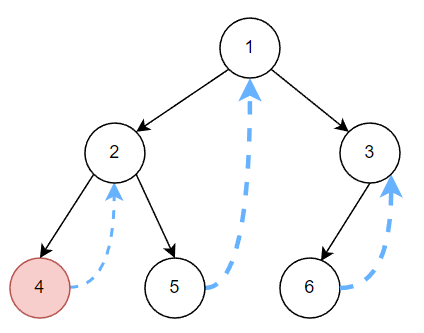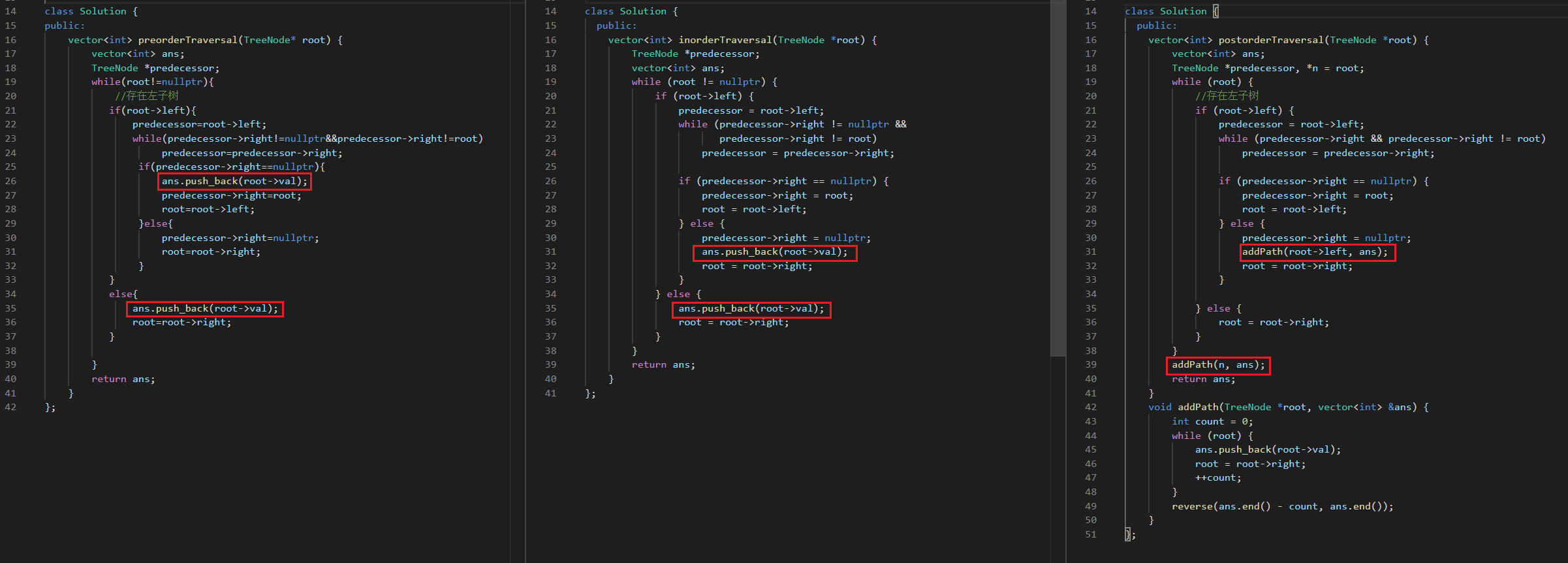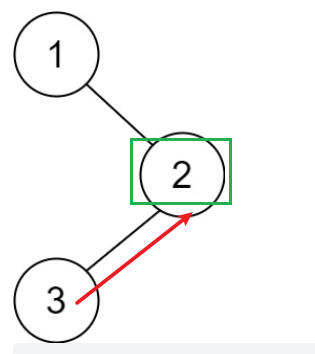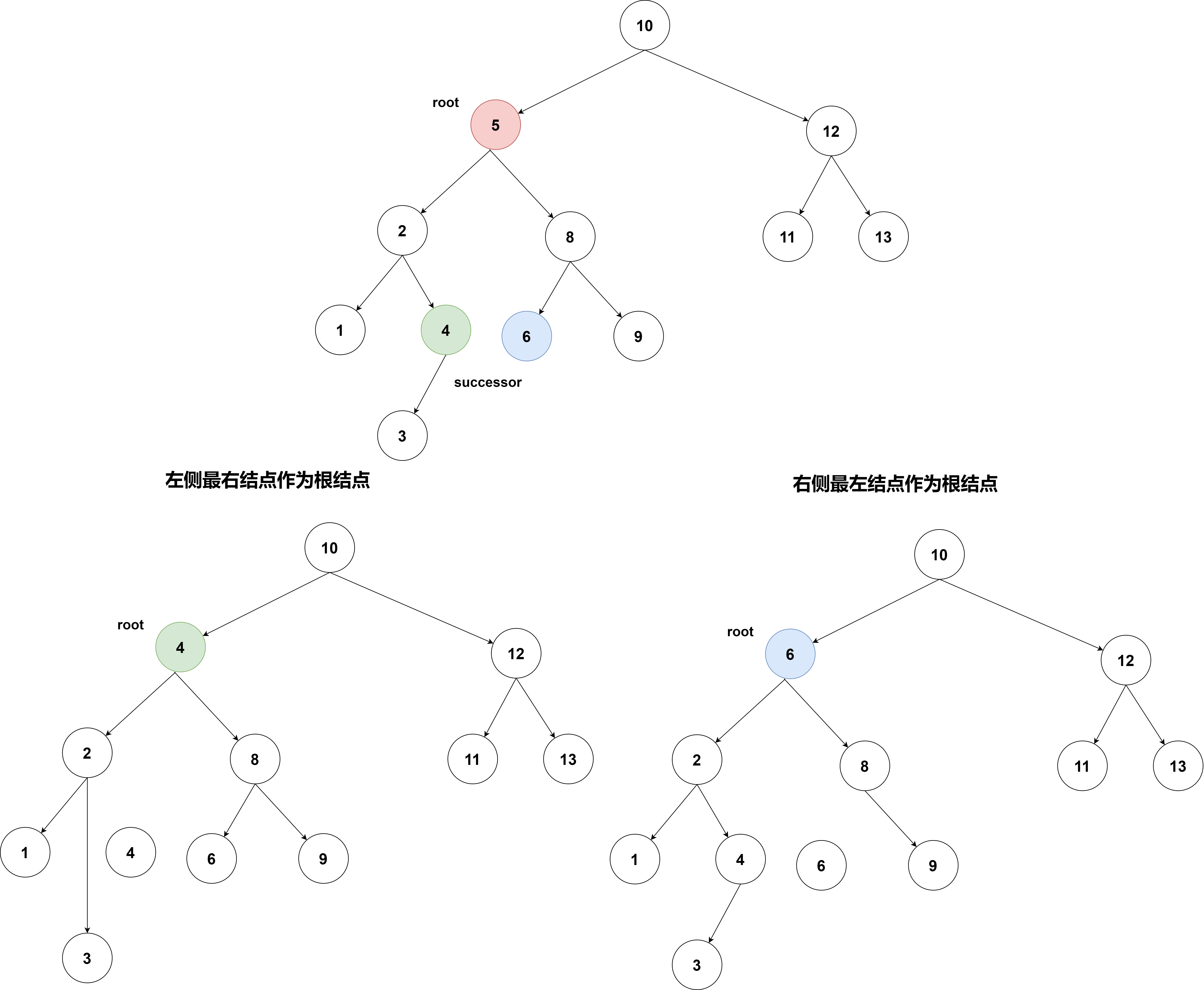二叉树
struct TreeNode { int val;TreeNode *left; TreeNode *right; TreeNode (int x) : val (x), left (NULL ), right (NULL ) {}};
完全二叉树是由满二叉树而引出来的,若设二叉树的深度为h,除第 h 层外,其它各层 (1~h-1) 的结点数都达到最大个数(即1~h-1层为一个满二叉树),第 h 层所有的结点都连续集中在最左边,这就是完全二叉树。
树的遍历:先根、中根、后根、层次
先根遍历(preorder)
递归
void preorder (TreeNode* root) if (!root) return ; ans.push_back (root->val); preorder (root->left); preorder (root->right); }
迭代
vector<int > preorderTraversal (TreeNode* root) { vector<int > ans; stack<TreeNode*> stk; while (!stk.empty ()||root){ while (root){ ans.push_back (root->val); stk.push (root); root=root->left; } root=stk.top (); stk.pop (); root=root->right; } return ans; } class Solution {public : vector<int > preorderTraversal (TreeNode* root) { stack<TreeNode *> stk; vector<int > ans; while (root!=nullptr ||!stk.empty ()){ while (root==nullptr &&!stk.empty ()){ root=stk.top (); root=root->right; stk.pop (); } if (root){ ans.push_back (root->val); stk.push (root); root=root->left;} } return ans; } }; class Solution {public : vector<int > preorder (Node* root) { vector<int > ans; if (root==nullptr ) return ans; stack<Node*> stk; stk.push (root); while (!stk.empty ()){ Node* cur=stk.top (); stk.pop (); ans.push_back (cur->val); for (int i=cur->children.size ()-1 ;i>=0 ;i--){ stk.push (cur->children[i]); } } return ans; } };
589. N 叉树的前序遍历 - 力扣(LeetCode)
Mirros遍历
vector<int > preorderTraversal (TreeNode* root) { vector<int > ans; TreeNode* predesessor; while (root){ if (root->left!=nullptr ){ predesessor=root->left; while (predesessor->right&&predesessor->right!=root){ predesessor=predesessor->right; } if (predesessor->right!=root){ predesessor->right=root; ans.push_back (root->val); root=root->left; }else { predesessor->right=nullptr ; root=root->right; } }else { ans.push_back (root->val); root=root->right; } } return ans; }
中根遍历(inorder)
二叉树的中序遍历 - 二叉树的中序遍历 - 力扣(LeetCode)
递归
inorder (root){ if (!root) return ; inorder (root->left); 处理根结点 inorder (root->right); }
时间复杂度:O(n),其中 n为二叉树节点的个数。二叉树的遍历中每个节点会被访问一次且只会被访问一次。
空间复杂度:O(n)。空间复杂度取决于递归的栈深度,而栈深度在二叉树为一条链的情况下会达到 O(n)的级别。
迭代
沿着左侧路径下降,访问该结点,转到右侧路径
vector<int > inorderTraversal (TreeNode* root) { vector<int > ret; stack<TreeNode*> stk; while (root||!stk.empty ()){ while (root){ stk.push (root); root=root->left; } root=stk.top (); stk.pop (); ret.push_back (root->val); root=root->right; } return ret; }
时间复杂度:O(n),其中 n为二叉树节点的个数。二叉树的遍历中每个节点会被访问一次且只会被访问一次。
空间复杂度:O(n)。空间复杂度取决于递归的栈深度,而栈深度在二叉树为一条链的情况下会达到 O(n)的级别。
Morris遍历
mirros记录了一条返回路径,可以通过该路径访问到下一个应该访问的节点
root沿着左子树下降,并记录左子树最右侧节点返回到当前节点的路径
访问完root的左子树后,应该返回到root
如果左子树的最右侧节点已经指向了自身,说明左子树已经遍历结束,当前遍历根节点,转向右子树
vector<int > inorderTraversal (TreeNode* root) { vector<int > ret; TreeNode *predesessor; while (root!=nullptr ){ if (root->left!=nullptr ){ predesessor=root->left; while (predesessor->right!=nullptr &&predesessor->right!=root){ predesessor=predesessor->right; } if (predesessor->right!=root){ predesessor->right=root; root=root->left; } else { ret.push_back (root->val); predesessor->right=nullptr ; root=root->right; } } else { ret.push_back (root->val); root=root->right; } } return ret; }
后根遍历
递归
inorder (root){ if (!root) return ; inorder (root->left); inorder (root->right); 处理根结点 }
迭代
class Solution {public : vector<int > postorderTraversal (TreeNode* root) { vector<int > ans; stack<pair<TreeNode*,int >> stk; while (root||!stk.empty ()){ while (root){ stk.push ({root,-1 }); root=root->left; } root=stk.top ().first; int mark=stk.top ().second; stk.pop (); if (mark==-1 ){ stk.push ({root,0 }); root=root->right; }else { ans.push_back (root->val); root=nullptr ; } } return ans; } };
class Solution {public : vector<int > postorderTraversal (TreeNode *root) { vector<int > res; if (root == nullptr ) { return res; } stack<TreeNode *> stk; TreeNode *prev = nullptr ; while (root != nullptr || !stk.empty ()) { while (root != nullptr ) { stk.emplace (root); root = root->left; } root = stk.top (); stk.pop (); if (root->right == nullptr || root->right == prev) { res.emplace_back (root->val); prev = root; root = nullptr ; } else { stk.emplace (root); root = root->right; } } return res; } };
Mirros遍历
class Solution {public : vector<int > postorderTraversal (TreeNode* root) { vector<int > ans; TreeNode* n=root; while (root){ if (root->left){ TreeNode* predecessor=root->left; while (predecessor->right&&predecessor->right!=root){ predecessor=predecessor->right; } if (predecessor->right==nullptr ){ predecessor->right=root; root=root->left; }else { predecessor->right=nullptr ; addPath (root->left,ans); root=root->right; } }else { root=root->right; } } addPath (n,ans); return ans; } void addPath (TreeNode* root,vector<int > &ans) int count=0 ; while (root){ ans.push_back (root->val); root=root->right; count++; } reverse (ans.end ()-count,ans.end ()); } };
Mirros遍历比较
LCA(latest common ancestor)
236. 二叉树的最近公共祖先 方法一
class Solution {public : TreeNode *ans; TreeNode* lowestCommonAncestor (TreeNode* root, TreeNode* p, TreeNode* q) { if (DFS (root,p)&&DFS (root,q)){ ans=root; }else { return NULL ; } if (lowestCommonAncestor (root->left,p,q)==NULL ){ lowestCommonAncestor (root->right,p,q); } return ans; } bool DFS (TreeNode* root,TreeNode *target) if (root==NULL ){ return false ; } if (root==target){ return true ; } return DFS (root->left,target)||DFS (root->right,target); } };
方法二
class Solution {public : TreeNode* lowestCommonAncestor (TreeNode* root, TreeNode* p, TreeNode* q) { if (root==NULL ) return NULL ; TreeNode*l=lowestCommonAncestor (root->left,p,q); if (l!=NULL ) return l; TreeNode*r= lowestCommonAncestor (root->right,p,q); if (r!=NULL ) return r; if (check (root,p)&&check (root,q)) return root; return NULL ; } bool check (TreeNode* root,TreeNode *p) if (root==NULL ) return false ; if (root==p) return true ; return check (root->left,p)||check (root->right,p); } };
方法三
class Solution {public : TreeNode *ans; TreeNode *lowestCommonAncestor (TreeNode *root, TreeNode *p, TreeNode *q) { DFS (root,p,q); return ans; } bool DFS (TreeNode *root, TreeNode *p, TreeNode *q) if (root==nullptr ){ return false ; } bool lson = DFS (root->left, p, q); bool rson = DFS (root->right, p, q); if ((lson&&rson)||((root==p||root==q)&&(lson||rson))){ ans = root; } return lson||rson||(root == p || root == q); } };
class Solution {public : TreeNode *lowestCommonAncestor (TreeNode *root, TreeNode *p, TreeNode *q) { if (root == nullptr || root == p || root == q) return root; TreeNode *left = lowestCommonAncestor (root->left, p, q); TreeNode *right = lowestCommonAncestor (root->right, p, q); if (left && right) return root; return left ? left : right; } };
方法四 哈希表,记录节点父节点
class Solution {public : unordered_map<int ,TreeNode*> fa; unordered_set<TreeNode*> visited; TreeNode* lowestCommonAncestor (TreeNode* root, TreeNode* p, TreeNode* q) { fa[root->val]=NULL ; DFS (root); while (p!=NULL ){ visited.insert (p); p=fa[p->val]; } while (q!=nullptr ){ if (visited.count (q)) return q; q=fa[q->val]; } return nullptr ; } void DFS (TreeNode* root) if (root->left!=NULL ){ fa[root->left->val]=root; DFS (root->left); } if (root->right!=NULL ){ fa[root->right->val]=root; DFS (root->right); } } };
树上倍增
1483. 树节点的第 K 个祖先 j个祖先节点,即从节点i跳2 j步到达的节点\
求节点node的第k个节点:
class TreeAncestor {public : vector<vector<int >> dp; TreeAncestor (int n, vector<int >& parent) { int m=32 -__builtin_clz(n); dp.resize (n,vector <int >(m,-1 )); for (int i=0 ;i<n;i++){ dp[i][0 ]=parent[i]; } for (int i=1 ;i<m;i++){ for (int x=0 ;x<n;x++){ int p=dp[x][i-1 ]; if (p!=-1 ) dp[x][i]=dp[p][i-1 ]; } } } int getKthAncestor (int node, int k) int m=32 -__builtin_clz(k); for (int i=0 ;i<m;i++){ if ((k>>i)&1 ){ node=dp[node][i]; if (node<0 ) return node; } } return node; } };
最近公共祖先(LCA):通过树上倍增求
1483. 树节点的第 K 个祖先 - 力扣(LeetCode)
首先使a和b处于同一深度
若跳$2^i$步后,x==y(a和b的LCA和以上节点都相同),则LCA为当前节点或者下面节点,不跳
若跳$2^i$步后,x!=y,则说明还未到达最近祖先节点,进行跳操作
class TreeAncestor { public : vector<vector<int >> pa; vector<int > depth; TreeAncestor (vector<vector<int >> &edges) { int n = edges.size () + 1 ; int m = 32 - __builtin_clz(n); pa.resize (n, vector <int >(m, -1 )); depth.resize (n); vector<vector<int >> g (n); for (auto [x, y] : edges) { g[x].push_back (y); g[y].push_back (x); } function<void <int , int >> dfs = [&](int x, int fa) { pa[x][0 ] = fa; for (int y : g[x]) { if (y != fa) { depth[y] = depth[x] + 1 ; dfs (y, x); } } }; dfs (0 , -1 ); for (int i = 1 ; i < m; i++) { for (int x = 0 ; x < n; x++) { if (int p = pa[x][i - 1 ]; p != -1 ) pa[x][i + 1 ] = pa[p][i]; } } } int getKthAncestor (int node, int k) int m = 32 - __builtin_clz(k); for (int i = 0 ; i < m; i++) { if ((k >> i) & 1 ) { node = pa[node][i]; if (node < 0 ) break ; } } return node; } int get_kth_ancestor (int node, int k) for (; k; k &= k - 1 ) node = pa[node][__builtin_ctz(k)]; return node; } int get_lca (int x, int y) if (depth[x] > depth[y]) swap (x, y); y = getKthAncestor (y, depth[y] - depth[x]); if (y == x) return x; for (int i = pa[x].size () - 1 ; i >= 0 ; i--) { int px = pa[x][i], py = pa[y][i]; if (px != py) { x = px; y = py; } } return pa[x][0 ]; } };
OptimalBST(最优搜索二叉树)
二叉查找树(Binary Search Tree,BST) 是一种特殊的二叉树:对于每个父节点,其左子节点的值小于等于父节点的值,其右子节点的值大于等于父节点的值。可以在$O(nlogn)$的时间内查找一个值是否存在。
class BST { struct TreeNode { int val; TreeNode *left, *right; }; class Solution { public : TreeNode *deleteNode (TreeNode *root, int key) { if (root == nullptr ) { return root; } if (root->val < key) { root->right = deleteNode (root->right, key); } else if (root->val > key) { root->left = deleteNode (root->left, key); } else { if (root->right == nullptr ) { return root->left; } if (root->left == nullptr ) { return root->right; } TreeNode *successor = root->left; while (successor->right) { successor = successor->right; } root->val = successor->val; root->left = deleteNode (root->left, root->val); } return root; } }; };
删除二叉搜索树中的节点 - 删除二叉搜索树中的节点 - 力扣(LeetCode)



